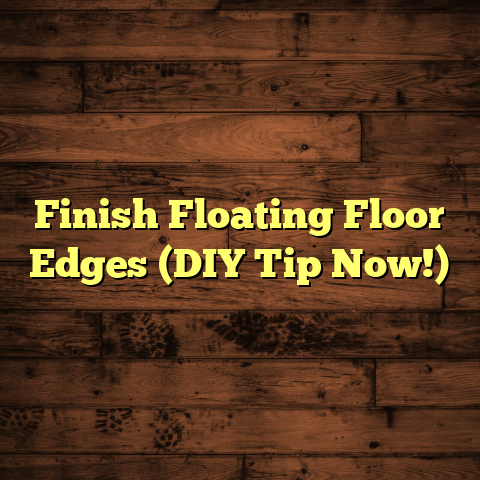Water Under Laminate: What To Do? (3 Fixes Now!)
Isn’t it ironic how we choose laminate flooring for its resilience and ease, only to find ourselves wrestling with puddles lurking beneath the surface?
One moment, your home is a tranquil oasis; the next,
it’s a mini swimming pool underfoot!
I’ve seen it
happen countless times in my years as a flooring
contractor, and believe me, it’s a common problem.
Water under laminate flooring is a headache, but it’s one you can tackle head-on.
This article will walk you through three actionable fixes to reclaim your floors and your peace of mind.
Section 1: Understanding the Problem of Water
Under Laminate
Let’s dive into why this happens and what’s at stake.
Subsection 1.1: Causes of Water Accumulation
So, how does water end up where it shouldn’t be?
Here’s the lowdown:
Plumbing Leaks: These are sneaky culprits.
A dripping pipe under the sink or a leaky dishwasher can slowly saturate the subfloor.
I’ve seen cases where homeowners didn’t even realize they had a leak until the laminate started to buckle.Humidity: In humid climates, moisture can seep in through poorly sealed windows or doors.
I remember one job in Florida where the humidity was so high, the laminate was practically sweating!Flooding: This one’s obvious but devastating.
Whether it’s a burst pipe or a natural disaster, flooding can quickly ruin laminate flooring.Spills: Accidents happen, right?
A spilled glass of water or a pet accident can seep through the seams of the laminate if not cleaned up immediately.
According to the American Housing Survey, about 14
million homes experience water leaks each year.
That’s
a lot of potential for water damage under your floors!
Subsection 1.2: Consequences of Ignoring
the Issue
Ignoring water under laminate is like ignoring a
toothache – it won’t go away on its own, and it will
only get worse.
Here’s what you’re facing:
Mold Growth: This is the big one.
Mold loves damp, dark places, and under your laminate is prime real estate.
Mold can cause health problems, from allergies to respiratory issues.Warping of the Laminate: Laminate is made of compressed wood fibers, which expand when wet.
This causes the planks to buckle, warp, and separate.-
Structural Issues: If the subfloor gets wet enough, it can rot and weaken, compromising the structural integrity of your home.
I once worked on a house where the homeowners ignored
a small leak for months.
By the time they called me,
the mold infestation was so bad that they had to
tear out the entire floor and remediate the mold.
Don’t let that happen to you!
Section 2: Fix 1 – The Quick Dry Method
Okay, let’s get to the good stuff: fixing the problem.
The Quick Dry Method is your first line of defense.
Subsection 2.1: Assessing the Situation
Before you start drying, you need to figure out how
bad the damage is.
Here’s how:
-
Visual Inspection: Look for obvious signs of water damage, such as buckling, discoloration, or gaps between planks.
Moisture Meter: This tool measures the moisture content of the flooring and subfloor.
A reading above 17% indicates a problem.
You can buy a decent moisture meter for around $30-$50.Sniff Test: Trust your nose!
A musty odor is a telltale sign of mold growth.
If the damage is minor and localized, the Quick Dry Method might be all you need.
Subsection 2.2: Implementing the Quick Dry Method
Alright, grab your tools, and let’s get started.
Here’s what you’ll need:
-
Fans: Box fans or oscillating fans will do the trick.
-
Dehumidifier: This is essential for removing moisture from the air.
-
Towels: For soaking up any standing water.
-
Spacers: Small objects to lift the laminate slightly (coins, small pieces of wood).
Steps:
-
Remove Standing Water: Use towels to soak up any visible water on the surface of the laminate.
-
Ventilate the Area: Open windows and doors to create airflow.
-
Position Fans: Place fans around the affected area to circulate air.
-
Run Dehumidifier: Set the dehumidifier to the lowest setting and let it run for 24-48 hours.
-
Lift Edges (Optional): If you can gently lift the edges of the laminate, insert spacers to create a small gap for air to circulate underneath.
Subsection 2.3: Monitoring Progress
Patience is key here. You need to make sure the water has completely evaporated.
How to check:
Moisture Meter: Use the moisture meter to check the moisture content of the flooring and subfloor.
You want it to be below 17%.-
Visual Inspection: Look for any signs of remaining moisture or damage.
-
Sniff Test: Make sure the musty odor is gone.
If the moisture levels are still high after 48 hours, you might need to move on to Fix 2.
Section 3: Fix 2 – The Lift and Dry Technique
Sometimes, the Quick Dry Method just isn’t enough.
That’s when it’s time to lift the laminate and get serious.
Subsection 3.1: When to Use This Method
You should consider the Lift and Dry Technique if:
-
The Quick Dry Method didn’t work: Moisture levels are still high after 48 hours.
-
The damage is more extensive: You see significant buckling or warping.
-
You suspect mold growth: You smell a strong musty odor.
Lifting the laminate allows you to dry the subfloor and underlayment directly, preventing further damage.
Subsection 3.2: Step-by-Step Instructions for
Lifting the Flooring
This requires a bit of finesse, but you can do it!
Tools you’ll need:
-
Pry Bar: For gently lifting the laminate planks.
-
Putty Knife: For separating the planks.
-
Gloves: To protect your hands.
-
Safety Glasses: To protect your eyes.
Steps:
-
Start at the Edge: Begin at the edge of the room, near a wall.
-
Remove Trim: Carefully remove the baseboards or trim pieces using a pry bar.
Pry Up First Plank: Use a putty knife to separate the first plank from the adjacent one.
Then, use a pry bar to gently lift the plank.Continue Lifting: Continue lifting the planks, working your way across the room.
Be careful not to damage the tongue-and-groove edges.Number the Planks: Use a marker to number the back of each plank.
This will make reinstallation much easier.
Subsection 3.3: Drying the Underlayment
and Subfloor
Now that the laminate is out of the way, you can focus on drying the underlayment and subfloor.
Steps:
-
Remove Wet Underlayment: If the underlayment is wet, remove it and discard it.
-
Clean the Subfloor: Use a shop vacuum to remove any debris or dirt from the subfloor.
Dry the Subfloor: Use fans and a dehumidifier to dry the subfloor.
This may take several days, depending on the severity of the water damage.Inspect for Damage: Check the subfloor for signs of rot or mold.
If you find any, you may need to replace the affected section.
Before reinstalling the laminate, make sure the subfloor is completely dry.
Section 4: Fix 3 – Replacement of Damaged Sections
Sometimes, no amount of drying can save your laminate.
If the damage is too severe, you’ll need to replace the affected sections.
Subsection 4.1: Identifying Damage
How do you know when it’s time to throw in the towel?
Look for these signs:
-
Buckling: The laminate is significantly warped or raised.
-
Warping: The planks are bent or twisted.
-
Discoloration: The laminate is stained or faded.
-
Mold Growth: You see visible mold on the surface of the laminate.
If you see any of these signs, it’s best to replace the damaged planks.
Subsection 4.2: Choosing Replacement Planks
Finding the right replacement planks is crucial for a seamless repair.
Here’s what to consider:
-
Type: Make sure the replacement planks are the same type of laminate as your existing flooring.
-
Style: Choose a style that matches your existing flooring as closely as possible.
Color: Match the color of the replacement planks to your existing flooring.
Keep in mind that colors can fade over time, so you may need to choose a slightly lighter shade.-
Thickness: Ensure the thickness of the replacement planks matches your existing flooring.
You can usually find replacement planks at your local home improvement store or online.
Subsection 4.3: Installation of New Planks
Installing replacement laminate is similar to installing new laminate flooring.
Tools you’ll need:
-
Tapping Block: For gently tapping the planks into place.
-
Pull Bar: For pulling the planks tight.
-
Hammer: For tapping the tapping block.
-
Measuring Tape: For measuring the planks.
-
Saw: For cutting the planks.
Steps:
-
Measure and Cut: Measure the area where you’ll be installing the replacement planks and cut the planks to size.
Install the Planks: Install the planks, following the manufacturer’s instructions.
Use a tapping block and pull bar to ensure a tight fit.-
Replace Trim: Reinstall the baseboards or trim pieces.
With a little patience and effort, you can seamlessly blend the new planks with your existing flooring.
Conclusion
Water under laminate is a common problem, but it’s one you can solve with the right approach.
Remember, addressing the issue quickly is crucial to prevent further damage.
Whether you choose the Quick Dry Method, the Lift and Dry Technique, or replacement of damaged sections, taking action will protect your floors and your home.
Laminate flooring is a great choice for its affordability and aesthetic appeal, but it requires proactive care to mitigate water-related issues.
Your home’s comfort is worth the effort!





